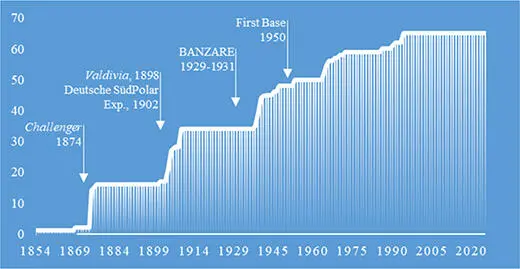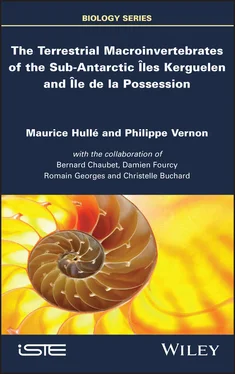1.4. Natural history and history of species discovery
Our current knowledge of native and introduced invertebrate species is based on the first scientific expeditions that took place in the second half of the 19th Century and the first half of the 20th Century (Box 1.1) and on the scientific programs that were initiated after the bases were settled.
The first species were brought back by the expeditions of the Erebus and the Terror in 1843, and the first descriptions were the weevil Ectemnorhinus viridis and the snail Notodiskus hookeri in 1853 and 1854, respectively.
Thirty years later, the very successful expedition of the Challenger allowed the description of 14 new species, mainly Diptera by Alfred Edwin Eaton and weevils by Charles Owen Waterhouse. At the end of the 19th Century and the beginning of the 20th Century, the expeditions of Valdivia (1898) and Gauss (1902) allowed the description of 18 new species, particularly by Günther Enderlein who described 15 native species including two moths of the genus Pringleophaga . The pre-war expeditions of Edgar and Andrée Aubert de la Rüe and René Jeannel allowed the description of spiders by Vernon Hickman and weevils by René Jeannel.
Thus, the discovery of 66 native species occurred over 140 years, from 1854 to 1994 (Figures 1.14 and 1.15).

Figure 1.14. Date and cumulated number of native species’ first description (cumulative data for the Îles Kerguelen and Île de la Possession)
More curiously, a few alien species have also been described from specimens found on the islands, even though these species may be common in their areas of origin. This was the case, for example, of the ant Camponotus werthi discovered by Emil Werth in 1902 (Deutsche Südpolar Expedition) and described by Auguste Forel (1908). This ant came from Cape Town in South Africa. Similarly, the book louse, Rhyopsocus eclipticus , described by Hermann August Hagen (1876), was discovered in Baie de l’Observatoire (Kerguelen) by the American expedition coming from Washington (USA), to observe the transit of Venus in 1874. It was probably introduced with the packing straws used on board the Swatara to protect the optical material. Similarly, the genus Limnophyes was created by Alfred Edwin Eaton in 1875 to describe the species L. pusillus , which was later renamed L. minimus , previously described by Johann Wilheim Meigen in 1818.
The 19th Century was the century of several important scientific expeditions. Scientists and hunters have come together for more than 150 years. The main scientific expeditions were as follows (Headland 1989; Delépine 1995):
1839–1843: the Erebus and the Terror commanded by James Clark Ross and Francis Crozier. Their main mission was the search for the magnetic pole, but naturalists like Robert McCormick, Joseph Dalton Hooker and David Lyall were also on board.
1874: the Challenger commanded by Georges Nares and whose chief scientist was Charles Wyville Thomson, a marine biologist, accompanied by the naturalists and zoologists John Murray, Rudolf von Willemoes-Suhm and Henry Nottidge Moseley.
1874: the Volage , the Supply , the Swatara , the Gazelle and the Monongahela to observe the transit of Venus. The astronomer Stephen Joseph Perry and the entomologist Alfred Edwin Eaton were present. These expeditions did not have only positive consequences since the first rabbits were released on Grande Terre (Îles Kerguelen) by the people aboard the Volage and the first dandelion seeds sown by those aboard the Swatara to provide food. This was the source of the first ecological disasters.
1898–1899: the Valdivia with the oceanographer Carl Chun as expedition leader, the botanist Wilhelm Schimper and the zoologist Ernst Vanhöffen on board.
1901–1903: the Gauss and the Tanglin with the geologist Erich von Drygalski as the outstanding “Deutsche Südpolar Expedition” leader. His goal was the Antarctic, but he organized a one-year stay on Kerguelen for five people including the scientists Emil Werth, Josef Ezensperger and Karl Luyken, and Ernst Vanhöffen was also on board.
1908–1909 and 1913–1914: the J.B Charcot and then the Curieuse led by brothers Raymond and Henri Rallier du Baty who drew the first good map of the interior of Kerguelen and made many observations of the flora and the fauna.
1924: the Oural with Etienne Peau, curator of Le Havre National History Museum, at Îles Kerguelen.
1928, 1931, 1949 and 1952: with Edgar and Andrée Aubert de la Rüe who came several times, essentially for geological studies.
1929–1931: the Discovery stopped at the Îles Crozet, the Îles Kerguelen and Heard Island before continuing south to Antarctica. This British, Australian and New Zealand Antarctic Research Expedition (BANZARE) was under the command of Douglas Mawson.
1938–1939: the Bougainville commanded by Henri Fabre de la Ripelle and with the entomologist René Jeannel on board. This expedition passed by Marion Island, the Îles Crozet and the Îles Kerguelen.
Box 1.1. Main scientific expeditions of the 19th and early 20th Centuries
Since the installation of the bases, scientific missions have been able to take place each year with stays of several months, first thanks to the “Mission de Recherche des Terres Australes et Antarctiques Françaises”, which became the “Institut Français pour la Recherche et la Technologie Polaires” (IFRTP) in 1992, and finally, the “Institut Polaire Français Paul-Émile Victor” (IPEV) since 2002. Fifteen new native species have been described since then. Many scientists have succeeded each other in the field. They collected many samples, which they identified themselves or entrusted the identification to specialized colleagues.
These expeditions also made it possible to draw up a complete list of the introduced species and to follow the history of their acclimation and expansion. This was the case, for example, for the ground beetle Merizodus soledadinus introduced at Port-Couvreux, Îles Kerguelen, in 1913, systematically researched by René Jeannel in 1939 and then by the different entomologists that have followed (see Figure 5.38).
The toponymy of the sub-Antarctic Îles Kerguelen and Îles Crozet (Delépine 1973) pays tribute to some of these pioneering scientists for invertebrate research: Lac Eaton, Péninsule Gauss, Cap Jeannel, Mont Moseley, Mont Etienne Peau, Port Perrier, Rivière Studer, Île Suhm, Bras Vanhöffen, Mont Werth and Mont Wyville Thomson are examples.
1.5. Current research on invertebrates
The study of macroinvertebrates is the subject of the research program “Subanteco” supported by the “Institut Polaire Français Paul-Émile Victor” (IPEV). This program seeks to evaluate the impact of environmental changes and biological invasions on native communities and more generally, on the functioning of terrestrial ecosystems. This program is based on the long-term monitoring of changes in the distribution of native and introduced species and on experimental designs, in order to respond to three main questions: 1) how much are distribution patterns and community structure of terrestrial fauna and flora changing over time? 2) What are the effects of changing environments and multiple stresses on species physiological ecology? 3) What are the dynamics of invasive species, and how much are they affecting sub-Antarctic biodiversity? This makes it possible to better understand the adaptive responses of species to changes and to better understand the processes underlying biological invasions. It also helps decision-making for those responsible for the management and development of these areas.
Читать дальше













